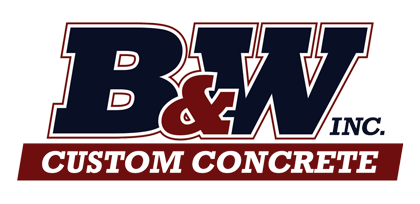B&W’s DIY Instructions
Say goodbye to concrete pits and stains. Smooth and beautify your damaged concrete surface with a floor “resurfacer”.
If you recently resurfaced your garage floor, check out tips on how to maintain your garage floor.
Materials needed:
Resurfacing products such as Quikrete Concrete Resurfacer or Sakrete Flo-Coat.
A band at least 3 ft. high to protect walls.
Push broom
Squeegee
1/2-inch drill and a mixing attachment.
Rubber boots and gloves, along with eye and hearing protection.
Pressure washer
Quikrete Concrete & Stucco Wash No. 8601-15.
Step 1 - Clean the slab and fill deep holes, cracks and damaged areas
Prepare the surface by scrubbing it with the brush and degreaser. Rinse twice with the pressure washer to remove residue.
Step 2 - Find the deep pits
With a pencil, circle ¼ inch around pits and craters.
Step 3 - Remove the loose stuff
Chisel any loose fragments along cracks or craters.
Step 4 - Fill cracks, craters, divots and pits with the concrete floor patch
Mix the resurfacer. Fill where needed and scrape off the excess until smooth.
Step 5 - Create a dam
Glue weather strip to the floor where the garage door rests to protect the driveway. Sweep then scrub any spots or stains with the concrete cleaner. Once done, apply cleaner to the whole slab. Starting in the back, use the pressure washer, moving forward so excess water goes outside.
If the cleaner beads up, there’s a concrete sealer on the surface. Apply a stripper then clean.
After cleaning, mark the pits and divots that may have surfaced. Chip and sweep away any pieces of concrete that the sprayer loosened. Mix resurfacer and fill the cracks. Smooth with a cement trowel.
If you have expansion joints, cut into the existing slab and put weather stripping into it. Apply and smooth up to 150 sq. ft. of resurfacer at a time. You can glue a length of weather strip to the slab to define a stopping point if you don’t have a control joint and then continue from there once the first section is smoothed out.
For a finished edge under the overhead door, apply a heavy-duty vinyl weather strip. Be sure the slab is dry or adhesive may not work properly.
Step 6 - Mix the resurfacer
You’ll need one person to mix and another to spread the resurfacer. The material begins to stiffen quickly, so the faster you get it applied, the better the results. The key to a smooth mix is to let the resurfacer sit for a few minutes after mixing. Then mix a bit more, scraping the sides.
Step 7 - Spread it smooth, then let it set
Saturate the concrete with water then use a broom to push any puddles away from the pitted areas or low spots. The concrete should be damp when you apply the resurfacer, not wet.
Spread from the middle of the puddle. Push the squeegee forward to work the resurfacer into the concrete, pores and pits.
Drag it back to smooth the coating and eliminate ridges. Continue spreading until you get even coverage. Strive for a ⅛ inch thickness.
As you reach the edge of the door weather strip, use your steel trowel to blend the resurfacer against it. Drop the excess in the bucket by removing with a trowel.
For a non-slip texture, lightly drag a push broom in one direction across the still-wet material within five minutes of setting time.
In hot, dry weather, mist the hardened surface. After several hours, it can handle foot traffic. If the pits still show, let the material set and apply a second coat. When complete, let it set for 24 hours before driving on it.
After a few days of curing, you can apply a sealer if you’d like to protect the slab from oil and other stains.
Step 8 - Erase your mistakes
If you end up with ridges, shallow craters, or squeegee marks, rent a concrete grinder. It will give the existing concrete a flatter surface so you want to apply a finish like epoxy coating which will make it easy to clean.
If this is too overwhelming, contact the experts at b&wconcrete.com for a free estimate.

